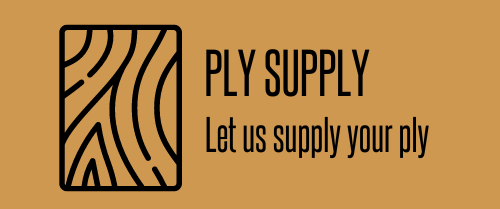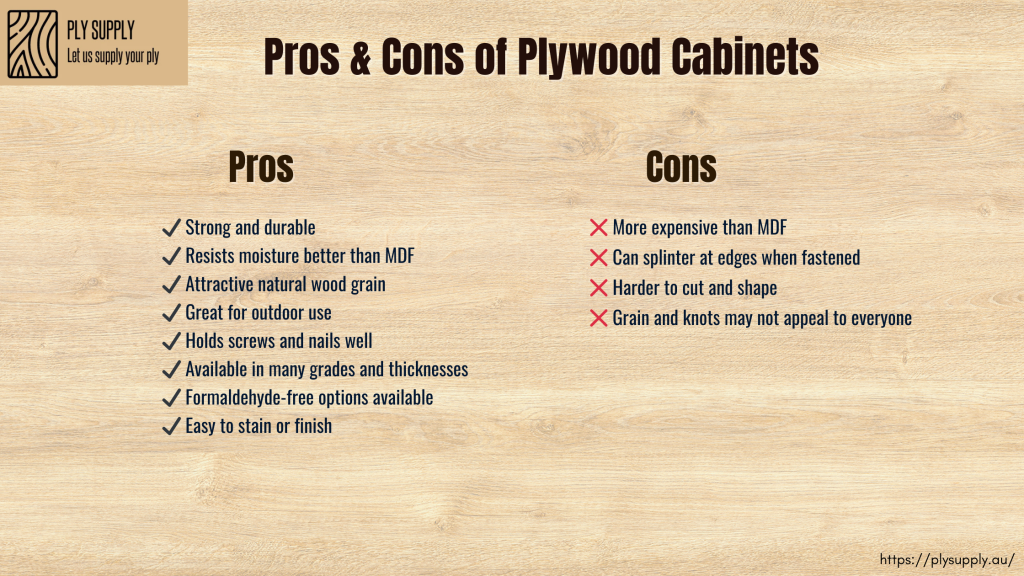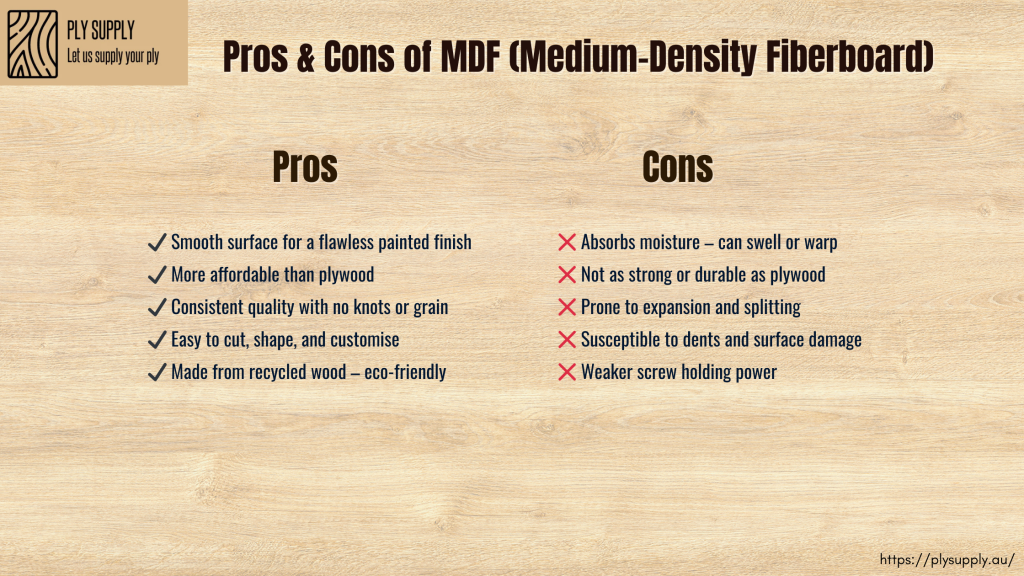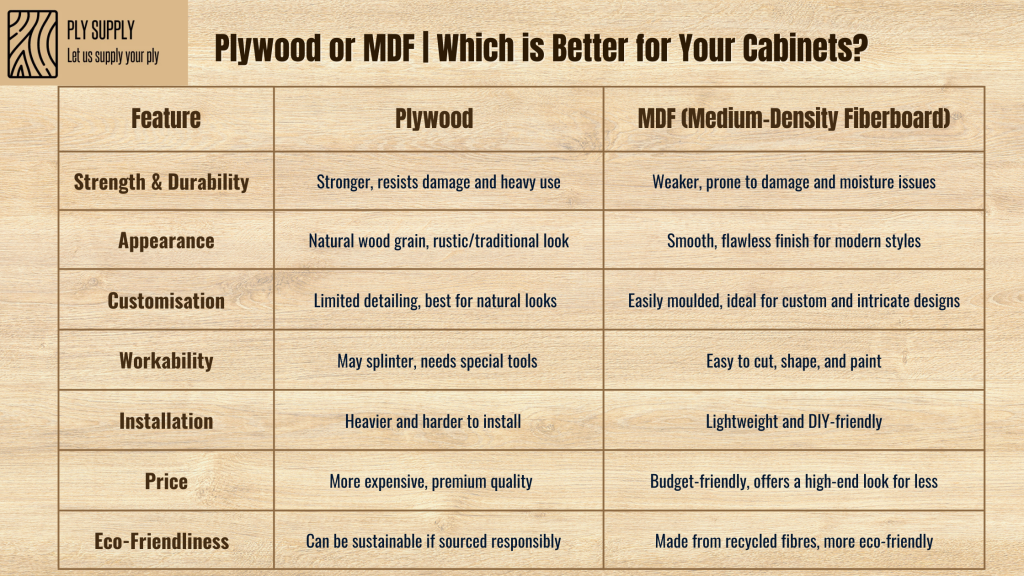Plywood or MDF: Which is Better for Your Cabinets?
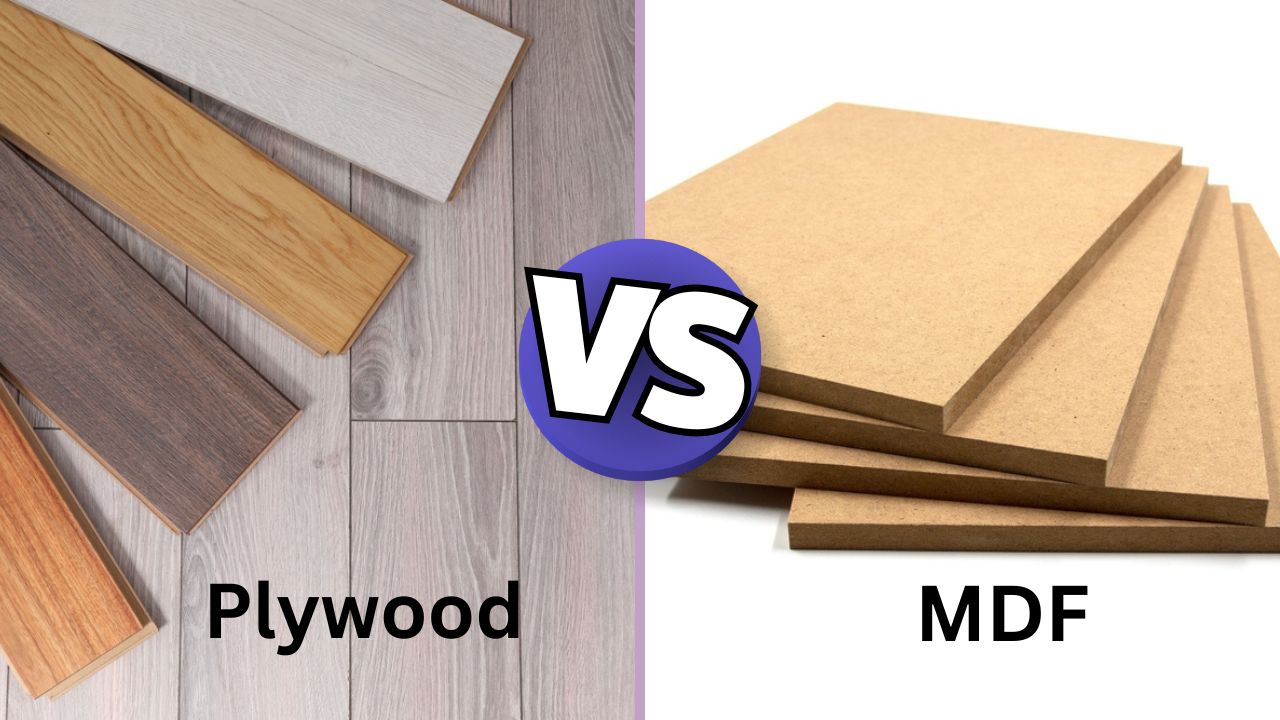
Cabinets play an important role in making your home storage space. Whether it’s in your kitchen, bathroom, or bedroom, choosing the right material for your cabinetry is key.
Here you get two choices and a confusion between plywood and MDF (Medium-Density Fibreboard).
The material you choose will affect not only the looks of your cabinets but also their durability and overall cost.
That’s why it’s important to understand the difference between MDF and plywood cabinets before making any final choice. Each material has its own strengths and weaknesses. And knowing these will help you make the best choice for your cabinetry.
In this blog post by Ply Supply, we’ll explore the pros and cons of plywood and MDF cabinets, providing a clear comparison to help you make an informed choice.
Let’s get started.
What Are Plywood Cabinets?
Plywood is a versatile material made by stacking thin layers of wood veneer, also known as plies, and bonding them together. The unique feature of plywood is its cross-grain construction in which each layer is rotated up to 90 degrees relative to the one below it.
This design gives plywood incredible strength, stability, and resistance to warping, making it a reliable choice for cabinets and other furniture.
Learn more about: Plywood Grades and Types
Let’s explore the pros and cons of plywood cabinets to know their key characteristics and weaknesses.
Pros of Plywood Cabinets
Exceptional Strength and Durability
Plywood is famous for being extremely strong and durable. This makes it a top choice for cabinets of daily use. Its unique cross-grain design helps distribute weight evenly. This minimises the chances of warping or sagging over time.
Versatile Options
One of the great benefits of plywood is its versatility. It comes in various thicknesses and grades. This allows you to pick the perfect material for your specific project. Whether you need something lightweight or a stronger option. Plywood has got you covered.
Better Moisture Resistance
When it comes to moisture, plywood exhibits better performance than MDF. It’s more resistant to humidity and can handle water splashes. With the right finishing or sealing, plywood can stand up to wet environments. This makes it a preferred choice for kitchens, bathrooms, and other areas where moisture is a concern.
Formaldehyde-Free Options
Many modern plywood products are free of formaldehyde. This makes them safer for your home.
Beautiful Natural Wood-like Look
Plywood retains the natural grain patterns of wood. This gives your cabinets a warm and authentic feel. The visible wood grain turns your cabinets into eye-catching focal points in any room.
Ideal for Outdoor Projects
Thinking about building furniture for your yard or outdoor space? Plywood is the way to go. Unlike MDF, which absorbs water easily and can warp. Plywood is more resilient in outdoor settings. It generally holds up better than MDF when exposed to external elements.
Strong Screw Holding
Plywood’s strong composition allows screws and nails to grip better. This makes it a better option for projects that involve many fasteners. But keep in mind that if you’re screwing or nailing into the edges of the wood. Plywood can be more prone to splintering than MDF. So, a little caution is advised.
Easy to Finish
Plywood can be stained or finished as you like and prefer. This results in minimal maintenance and easy upkeep.
Cons of Plywood Cabinets
- Higher Cost: Plywood is generally more expensive than MDF. It’s because of its better quality and more complex manufacturing process.
- Variable Appearance: While many people love the natural look of plywood, others might not. The visible wood grain and knots can be less appealing compared to the smooth finish of MDF.
- Workability Challenges: Working with plywood can be more complicated than with MDF. Its thicker and sometimes uneven surface requires specialised tools and techniques for cutting, shaping, and joining plywood components.
What Are Medium-Density Fiberboard Cabinets?
Medium-density fiberboard (MDF) is an engineered wood product created by breaking down leftover hardwood or softwood into fine wood fibers. These fibers are combined with wax and resin, then compressed under high heat and pressure to form dense, uniform panels.
Known for its smooth surface and versatility, MDF is a popular choice for cabinetry, offering a reliable and cost-effective option for many design styles.
Now, let’s move towards the pros and cons of MDF cabinets.
Pros of MDF Cabinets
Smooth Surface & Finish
One of the standout benefits of MDF cabinets is their ability to deliver a stunningly smooth finish when painted. Because of its dense structure, MDF allows paint to stick well. This results in a consistent and professional look.
Budget-Friendly Choice
MDF is often a more cost-effective option compared to plywood. If you’re working on a project where budget matters. MDF can provide the quality you want without breaking the bank.
Consistent Quality Throughout
MDF panels are made with uniform materials. This means they’re free from the knots and imperfections often found in natural wood. This consistency ensures that every part of your cabinet is of high quality, making the assembly process simpler and more reliable.
Easy to Cut and Shape
MDF is easy to cut into different shapes. When you make cuts, the edges come out clean and smooth, with no splintering. This quality makes MDF perfect for complicated designs. This allows you to be creative without hassle.
Environmentally Friendly Option
MDF is made from recycled wood fibres. That’s why it is a more sustainable choice for your cabinetry. By using leftover wood materials, MDF helps reduce waste and supports eco-friendly practices.
Cons of MDF Cabinets
- Moisture Sensitivity: A significant drawback of MDF is that it’s prone to moisture. It can swell, warp, or even break down in humid conditions or when exposed to water. That’s why it’s not the best choice for kitchens, bathrooms and other areas prone to moisture.
- Limited Strength: While MDF is strong, it doesn’t match the strength of plywood. This can affect the durability of MDF cabinets, especially when bearing heavy loads.
- Expands Easily: MDF can easily expand when exposed to water and temperature changes. This can lead to splitting.
- Lower Impact Resistance: MDF is generally more prone to surface dents and damage compared to plywood. This makes it less ideal for environments where heavy use is expected.
- Screw Holding Weakness: MDF doesn’t hold screws as securely as plywood. This can be a concern for cabinetry that relies on screws for assembly.
Explore more about: How to Choose a Custom Cabinet Maker in Perth?
Plywood vs. MDF | 7 Key Differences
To help you make the best choice, let’s have a look at the difference between plywood and MDF.
1. Strength & Durability | What Lasts Longer?
Plywood | MDF |
Plywood is the sturdier option, offering exceptional strength and resistance to damage. Its cross-grain structure gives it more stability, making it a great choice for cabinets that need to withstand heavy use or high-traffic areas. | MDF is a dense material, but it’s not as strong as plywood, especially when dealing with heavy loads or impact. It’s more prone to damage, and moisture is its biggest weakness. If exposed to water or humidity, MDF can swell or warp over time. |
2. Appearance | Sleek vs. Natural
Plywood | MDF |
Plywood offers a more natural look with visible wood grain and texture. It’s perfect for rustic or traditional designs and gives a warm, organic feel to cabinets. | MDF has a smooth, even surface that creates a sleek, modern appearance. It’s great for painted finishes and is often used in minimalist or contemporary styles. |
3. Versatility | Which Is Best for Customisation?
Plywood | MDF |
Plywood is versatile but not ideal for fine detailing. It works well in many cabinet styles, especially when you want a natural wood finish. | MDF is easy to customise. It can be carved, moulded, or cut into detailed shapes, making it a top choice for custom cabinets with unique designs. |
4. Workability | Ease of Cutting and Customisation
Plywood | MDF |
Plywood can be tricky to cut, as it might splinter due to its layered construction. Special tools may be needed for precise work. | MDF is easier to cut and shape. It doesn’t splinter and works well for detailed designs. It’s also great for painting and finishing. |
5. Ease of Installation | Which Is Easy to Install?
Plywood | MDF |
Plywood is heavier and can be harder to install, especially for large cabinets. It may need extra support to stay secure over time. | MDF is lighter and easier to handle, making installation quicker. It’s a good option for DIY projects and fits together neatly. |
6. Price | What Fits Your Budget?
Plywood | MDF |
Plywood is more expensive because of its strength and high-quality materials. It’s a smart investment for long-lasting cabinets. | MDF is more affordable and ideal if you’re on a budget. It still looks great, especially when painted or finished well. |
7. Eco-Friendliness | Which One is Sustainable?
Plywood | MDF |
Plywood can be eco-friendly if it comes from sustainable sources. Some versions are made from responsibly harvested wood. | MDF is often made from recycled wood fibers, making it a greener choice. It helps reduce waste and the need for new trees. |
So, Which One is Better for Cabinets? Plywood or MDF?
Choosing between MDF and Plywood for your cabinets really depends on what your project needs, how much you want to spend and the style you’re going for.
Most professionals and cabinet makers in Perth prefer Plywood when strength, water resistance, and durability matter. It’s widely used in custom kitchen cabinetry, commercial fit-outs, and luxury interiors.
But MDF still has its place, especially where budget and smooth finishes are priorities.
In the debate of Plywood vs MDF for Cabinets, here’s a quick takeaway:
- Go with Plywood if you’re after strength, moisture resistance, and a natural wood appearance. It’s the better choice for high-use areas like kitchens, bathrooms, or laundry rooms, where durability and water resistance really matter. Plus, it holds screws well and adds long-term value to your cabinets.
- Choose MDF if you’re working indoors in dry conditions, want a super-smooth painted finish, or are sticking to a tighter budget. It’s ideal for wardrobe doors, feature walls, and decorative cabinetry.
Are you looking for high-quality plywood for your cabinetry? Need help choosing the right cabinet plywood?
We’ve got your back!
Shop Quality & Durable Plywood at Ply Supply Today
We pride ourselves on providing high-quality cabinet plywood with H2S Glueline Termite Treatment. It ensures durability and long-lasting performance. Whether you need structural and non-structural plywood or hardwood plywood. We have the perfect solution for your cabinetry projects.
Don’t compromise on quality! Give your cabinets the upgrade they deserve.
